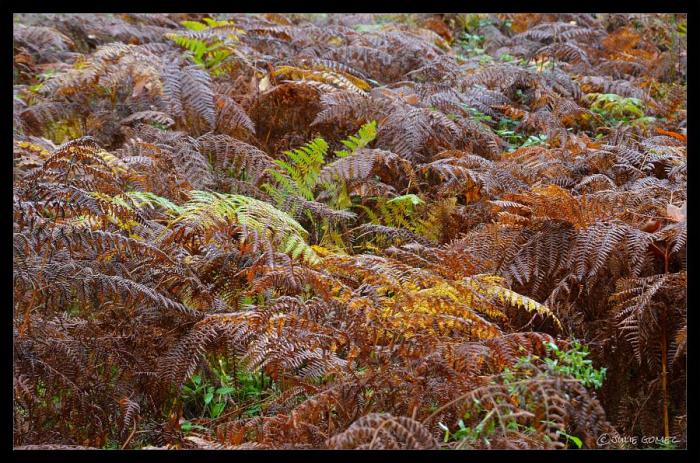
Autumn carries more gold in its pockets than any other seasons.
–Jim Bishop (1907-1987) American journalist and author
❀ ❀ ❀ ❀ ❀
It had been a long, dry summer, and I wondered if autumn would ever arrive. September was also warm and dry. When the calendar turned to October, I was sure the rains would come, and the nights would turn colder. But no, in fact, October turned out to be our warmest October on record! Trees still held full green canopies. Even the leaves of the huckleberry, salmonberry, and elderberry shrubs, which are the first to turn and fall, were still green. The varied thrushes returned October 1, a month earlier than last year. Expecting to find leaves they would flip like pancakes in search of grubs, they found none.
Rain fell during the last few days of October; steady, warm rain that was followed by a few cool nights of 39 degrees. Not bone chilling by any means, but cold enough to slow the chlorophyll in the leaves that runs through their veins. On November 1, the slight cool down was enough to jumpstart the leaves to color.
A mix of fog and drizzle shrouded the mountains, and the woods were a vivid collage of bronze and gold. Complete changes overnight; it was like waking up to the first snow of the season. It felt like Christmas. Through a double pane window was no way to appreciate such a gift, so I opted for a hike. The weather wasn’t the greatest, but we refused to let it stop us. Besides, what sort of Oregonians would we be if we did that? Chris suggested Milo McIver State Park. That would be fine. I knew he had fishing on the brain and wanted to check out Dog Creek. And I was eager to see all the wonderful things that the McIver woods would offer.
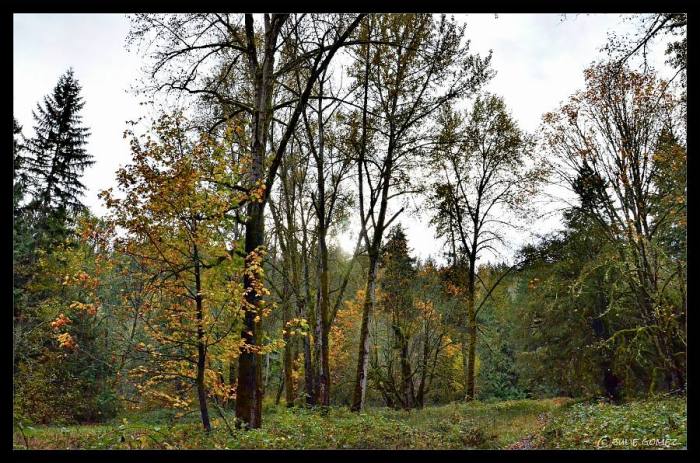
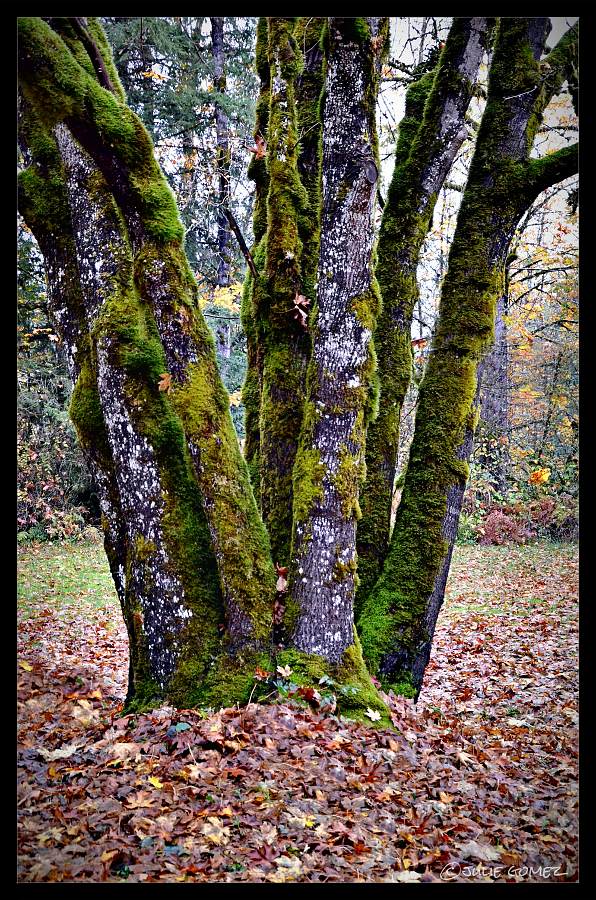
The bad weather lifted, and through the clouds, the sun struggled. McIver woods shined bright, drenched with colors of orange, bronze, and gold; reds shone most sparingly. The air was cool and damp. And given that November is our wettest month, one could not complain. A nearly parking lot meant that fishing was slow. The salmon had returned in a flash to Dog Creek. Now it was time to welcome winter steelhead. Along the trail, we passed by my favorite bigleaf maple tree. It puts on a fabulous show every autumn. Expecting to see it in its full leafy dress, its branches were bare, its leaves piled on the ground. All the other maple trees had their leaves, so why not this one? It reminded me of the Charlie Brown Christmas tree, when all the needles fell off.
Autumn this year was a confusing time not just for the plants, but for the animals too. We didn’t get far along the trail when I stopped (I stop a lot) to watch and photograph a European garden spider spinning her web. She was not alone. There were dozens more just like her, stringing their large morning webs in the clearing. The garden spider often eats its own web at the end of each day, and then builds a new web each morning. Now how ingenious is that?
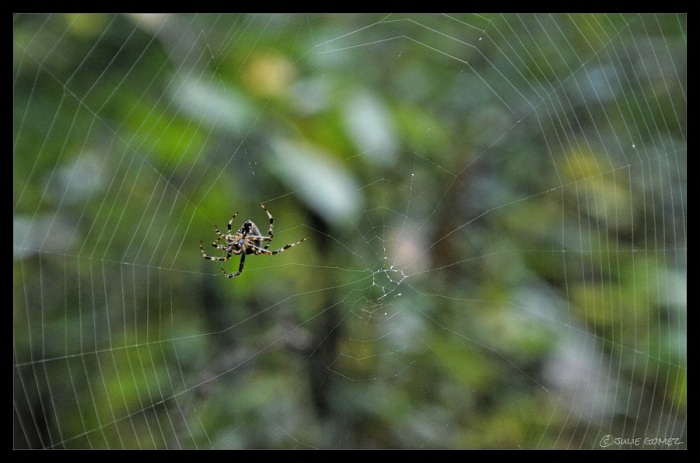
Up ahead, Chris motioned for me. Pressing a finger to his lips, he pointed at the ground. I hurried over quietly to see what it was. In the middle of the trail, trying to camouflage itself among the leaves was a young garter snake. Thank goodness he was watching where he walked or he might have stepped right on it! The little snake should be hibernating, but like the trees that still had their leaves, and the garden spiders that still spun their webs, it too was confused by the unseasonably warm weather. But what an exceptional find so late in the year. Gently, I ran my fingers along its silky smooth back. This got the little snake moving again. It went straight for the woods where it would hopefully find a cozy log to curl up in until spring.
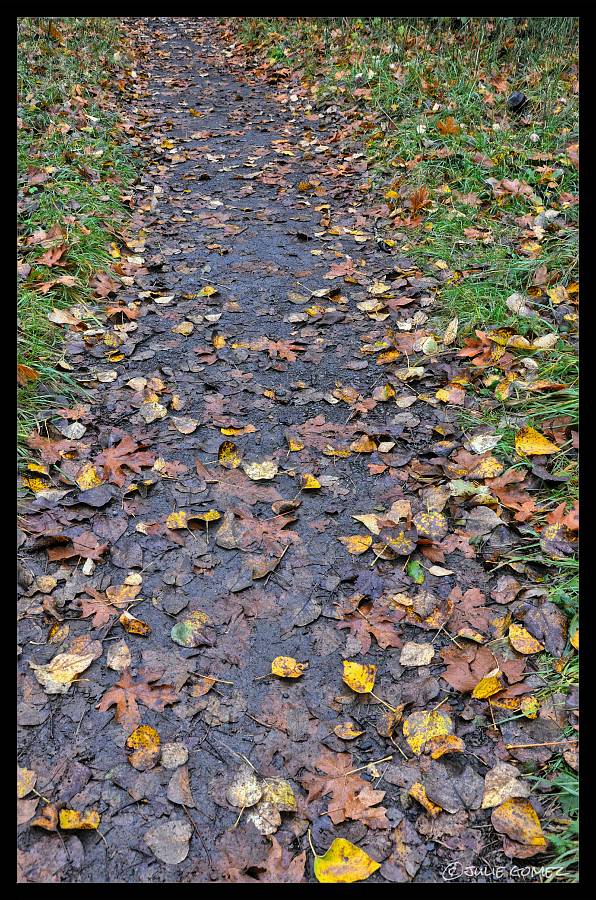
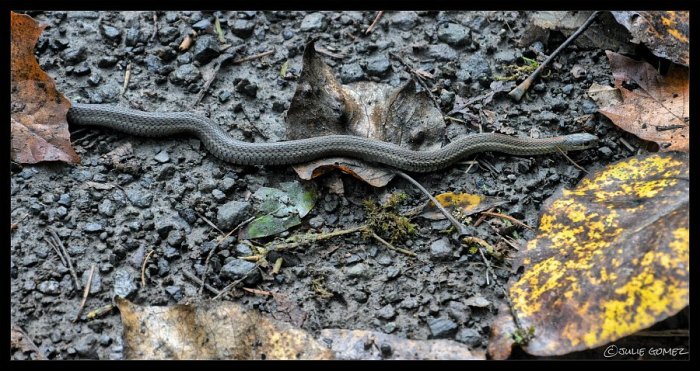
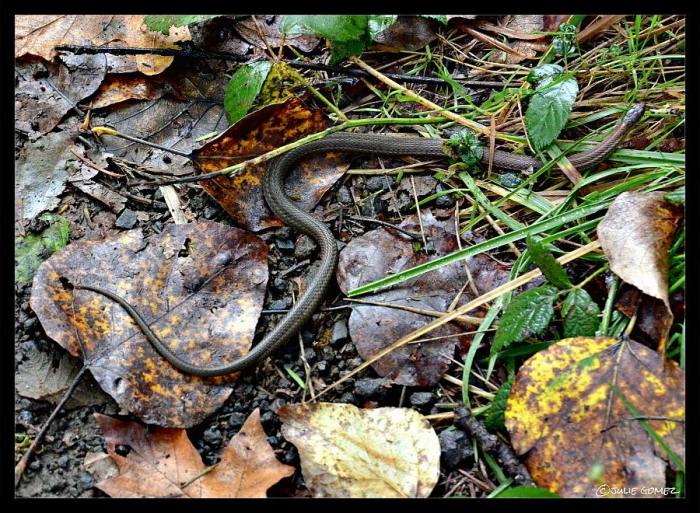
Only a few people were fishing the mouth of Dog Creek when we arrived. The Clackamas River flowed past at a brisk pace. Its watery song, a low roar. A fly-fisher we talked to said he’d caught several steelhead the day before, but that things were slower now. One couple that was leaving had caught a trout. River trout are out-of-season this time of year, and this was but one more example of poaching, and no regard for the law. We took the trail to the footbridge of Dog Creek. There, we stirred a great-blue heron and a belted kingfisher that were hunting and feeding. The heron took flight into the woods. The kingfisher also fled, scolding us with its loud rattling call. And no wonder! On the railing of the footbridge were pieces of crayfish. Poor thing, we’d interrupted its meal. We left with the hope that the kingfisher would return.
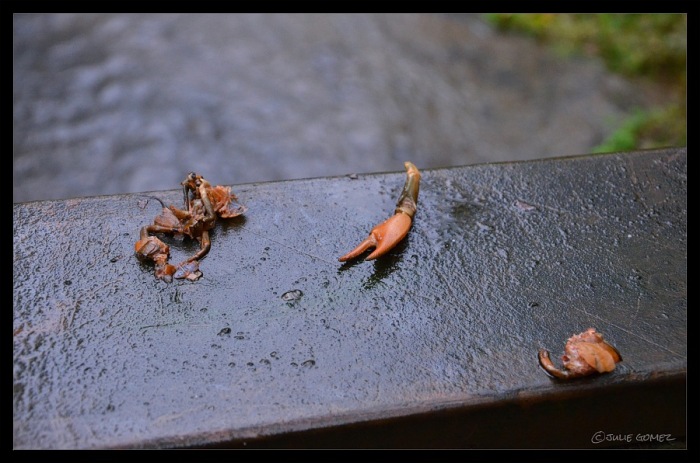
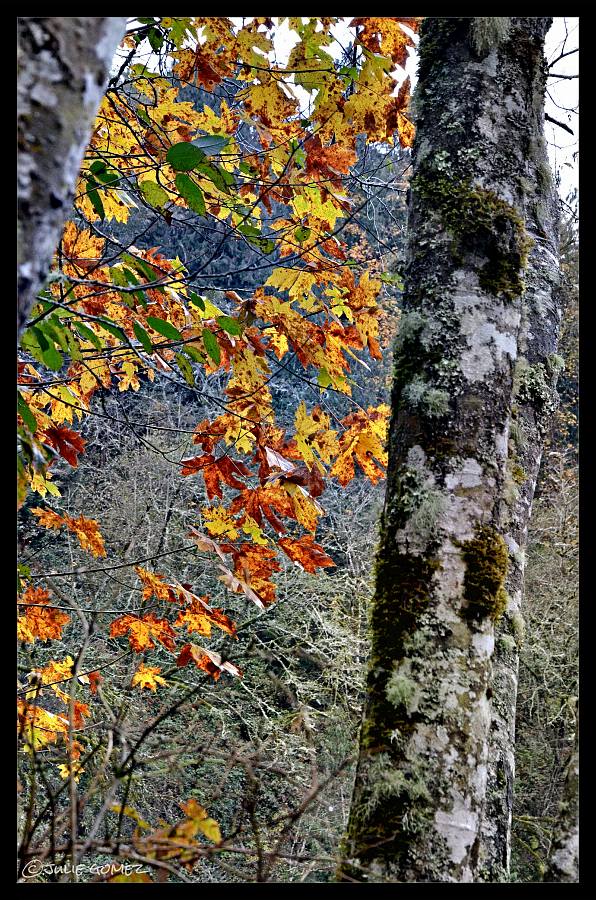
Back along the Clackamas River, the trail was crowded with willows and alders. Chris stopped to fish. I went on ahead. It was a terrific day to be outdoors. A dipper flew to shore where it paused to eye a cottonwood leaf. Across the river, I spied two osprey nests in the tops of the fir trees. Large, bulky stick nests now vacant for the season. How I would love to see their occupants! I must return here in the summer with my big lens and tripod. Time flew by, and before we knew it, it was time to go for the park gates closed at dusk. Starting back, I saw a rough-skinned newt next to the trail. Her russet skin made for good camouflage. She might have gone unnoticed had it not been for her bright orange belly. Like the garter snake, she was looking for a place to spend the winter. I picked her up. Her granular skin was cold and slightly sticky. She didn’t struggle much, possibly enjoying the warmth of my hands. I put her down on a tuft of moss on the other side of the trail in the direction she was traveling. She would be safer there, and I wished her well on her fall migration.
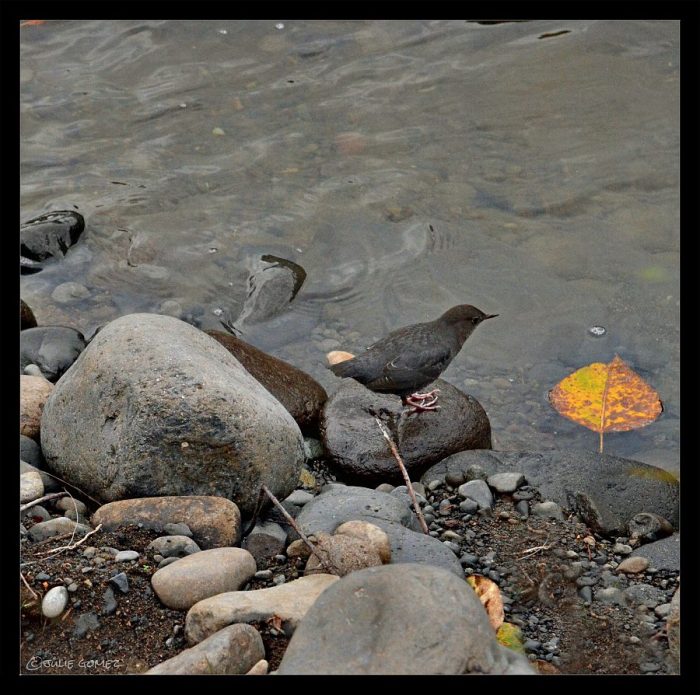
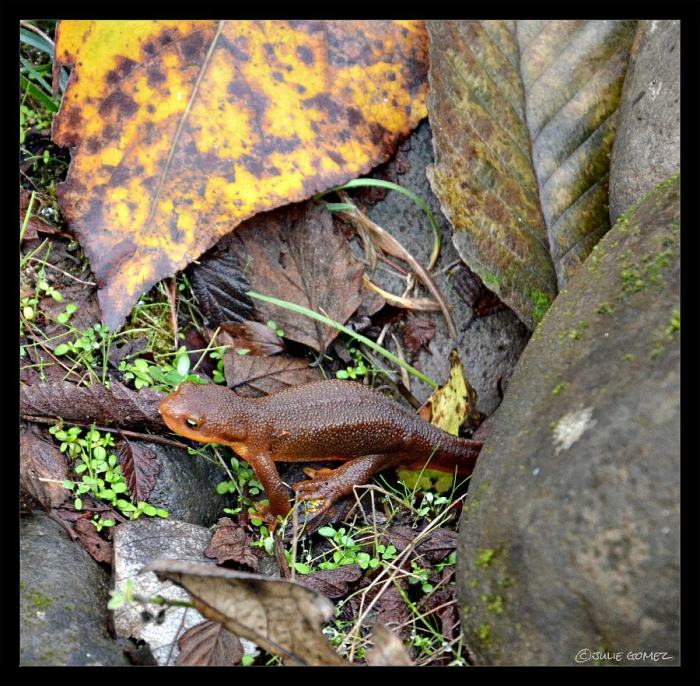
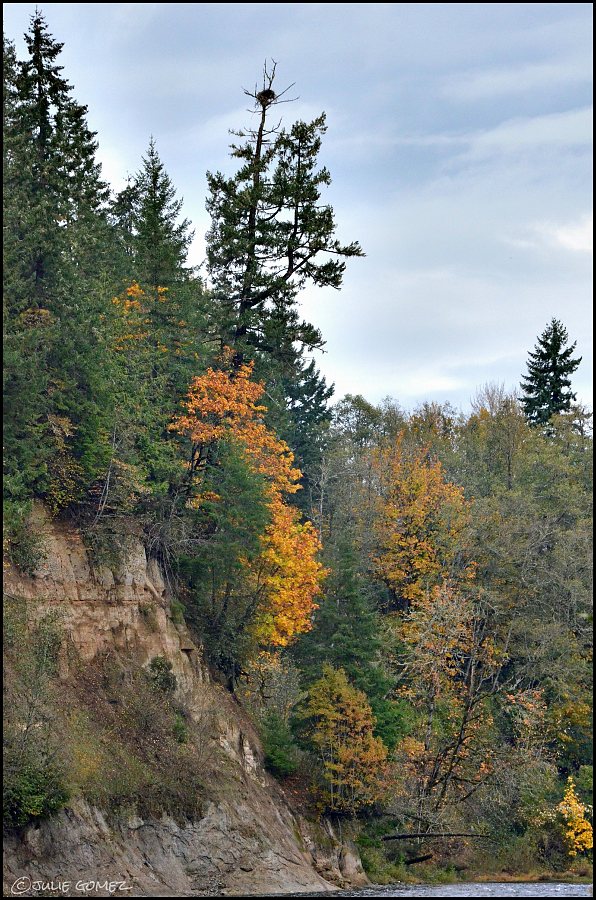
It was a fine day. It had felt good to stretch our legs on the trail, to meet unexpected creatures, and to see some color in the trees. Autumn didn’t come to the mountains as expected. I will remember it as the time when autumn almost wasn’t. A week after our visit to the McIver Woods, the temperatures plummeted, and the woods turned cold and white.
____________________
Copyright 2014. All rights reserved.
Thank you for stopping by!
